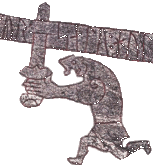 Abstract: This document describes constructs used in multiplayer
games. The document is loosely related to the Haven project but should be
applicable outside that project with no modifications.
Abstract: This document describes constructs used in multiplayer
games. The document is loosely related to the Haven project but should be
applicable outside that project with no modifications.
Availability: Public
|
Availability: Public |
|
Pattern Template
This is a descriptive name for the pattern |
| Problem: |
| Solution: |
| Consequence: |
| Examples: |
| Discussion: Optional. May contain background
and develop some aspect of the problem and solution. |
| Comment: Some patterns contain a comment.
Among other notes, this is where relation to other patterns are mentioned.
References to pattern descriptions in other sources are here as well. |
| Other Names: Sometimes it is necessary to
clarify what is and what is not a use of the pattern. |
|
Receipt
|
||||||||||||
| Problem: To allow players to make progress
in a storyline |
||||||||||||
| Solution: Introduce some sort of milestone
or landmark action representing the essence of the achievement. |
||||||||||||
| Consequence: In the eyes of the player,
the receipt will represent progress. |
||||||||||||
| Examples: If a game has progress, it is
either a continuous scale or discrete events. Sometimes discreet events are
visible to the player, such as a response in a MUD or MMORPG NPC dialog. Consider the following MMORPG dialogue between player ("Neo") and NPC ("Child"):
The Receipt usage in this dialogue is the response to the character's repetition of the key phrases ("truth", "no spoon") - these responses are examples of visible receipts. They let the player know that he is making progress. Upon hearing the word "truth", the NPC responds by revealing new keywords. |
||||||||||||
| Comment: This is a special case of the
Milestone Pattern. See also the Requirement Pattern to which this is the companion
pattern. The Receipt Pattern is not specific to multiplayer scenarios. |
|
Requirement
|
| Problem: A task put before the player
is described as a collection of requirements the player needs to fulfill
to achieve his objectives. |
| Solution: |
| Consequence: |
| Examples: |
| Comment: This is the companion pattern
to the Receipt Pattern. A Requirement fulfilled usually results in a Receipt.
The Requirement Pattern is not specific to multiplayer scenarios. |
| Other Names: |
|
Milestone
|
| Problem: |
| Solution: |
| Consequence: |
| Examples: |
| Comment: The Milestone Pattern is not
specific to multiplayer scenarios. |
|
Experience
|
| Problem: |
| Solution: |
| Consequence: |
| Examples: |
| Comment: This is a special case of the
Milestone pattern. The Experience Pattern is not specific to multiplayer scenarios. |
|
Sum is Greater Than Parts
|
| Problem: To encourage diversity in player
choice |
| Solution: In a set of available (and approximately
equally beneficial) paths, encourage diversity by making different-choice
groups more capable of solving tasks than single-choice groups. |
| Consequence: |
| Examples: |
| Discussion: The sum of players may be
greater than the parts even in single-choice groups. In a time-regulated
situation (group capability governed by the pace at which the group members
regain power needed for progress), a group of two will overcome the obstacle
in half the time - during that time the drain on the regulated resource may
be less than half, meaning the group can accomplish more than 2 x the progress
single players could. However, the pattern may still be valid if a multi-choice
group has even greater potential than a single-choice group. |
| Comment: The Sum is Greater Than Parts
Pattern is not specific to multiplayer scenarios - other situations where
it might occur are strategy games where diversifying one's forces may be more
advantageous than having fewer types of units, or RPG party composition. |
|
Coalition
|
| Problem: |
| Solution: |
| Consequence: |
| Examples: |
|
Faction
|
| Problem: |
| Solution: |
| Consequence: |
| Examples: |
|
Information Filter
|
| Problem: |
| Solution: |
| Consequence: |
| Examples: |
| Comment: The Information Filter is not
specific to multiplayer scenarios. |
|
Avatar
|
| Problem: |
| Solution: |
| Consequence: |
| Examples: |
This text was written by Olof Ekström. For more information about the author of this page, see Olof Ekström's personal information in the Project Profiles document.
Copyright © 2002 Olof Ekström/Extro System. All rights reserved.
Bälinge/Uppsala, Sweden, March 2002